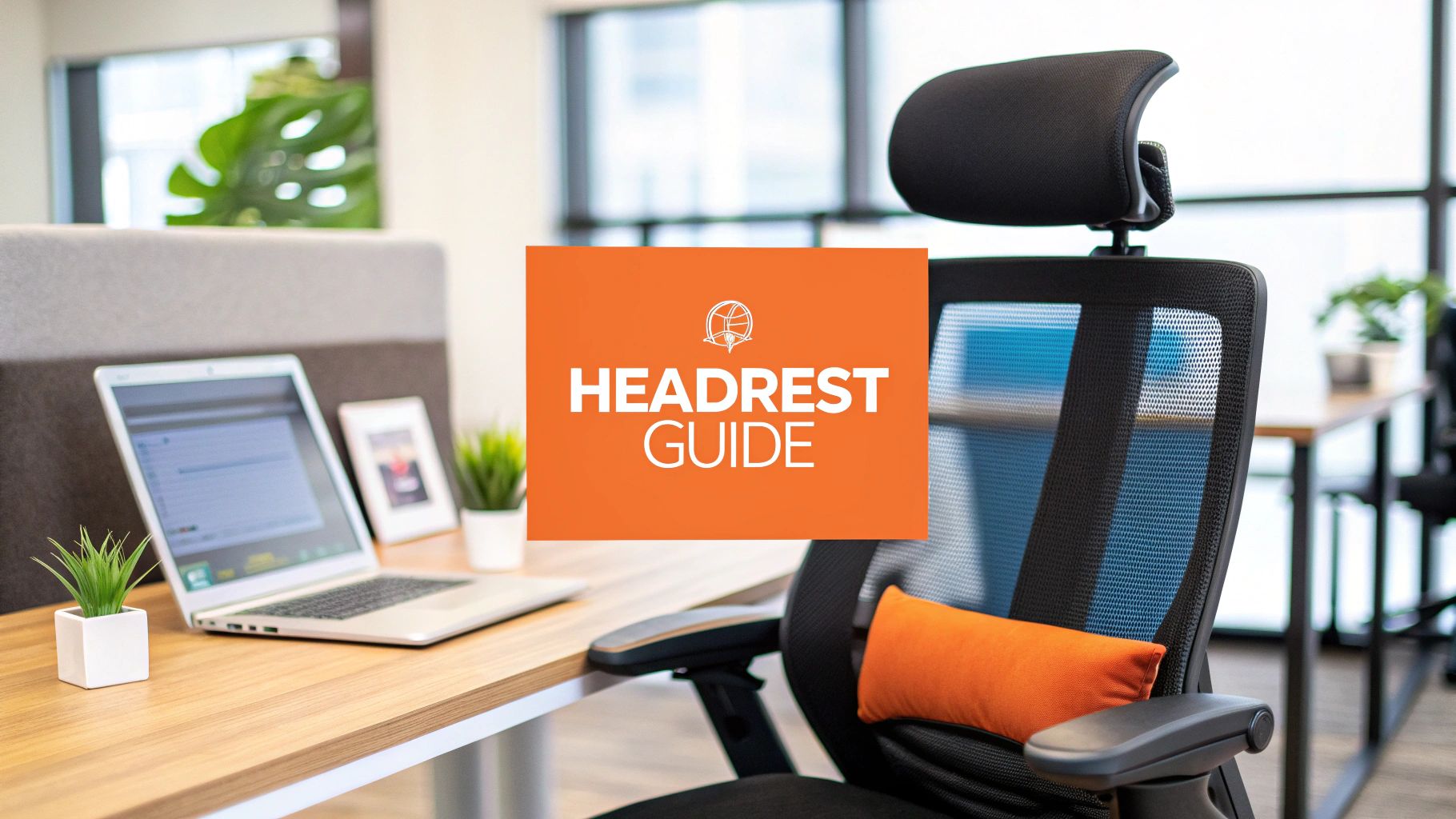An office chair headrest is a vital support system for your head and neck, designed to take the pressure off your cervical spine. It's easy to dismiss it as a luxury add-on, but it's really more of a crucial safety net for your posture, especially for those moments when you lean back to think, take a call, or just take a breather from a hectic day.
Headrest vs No Headrest: Key Differences
To really understand the impact, let's break down the immediate ergonomic differences between a chair with a headrest and one without. The table below shows just how much support you're missing out on without one.
As you can see, a headrest isn't a minor feature; it's a fundamental component for achieving proper ergonomic support throughout the workday.
From Optional Extra to Ergonomic Necessity
It’s best to think of a headrest as a core part of your ergonomic toolkit, not just a decorative touch. We all accept that lumbar support is essential for protecting the lower back, and a quality headrest does the same thing for the top of your spine. It’s engineered to keep your head and neck properly aligned, stopping you from slumping into that forward-leaning posture that so often leads to pain.
This support becomes absolutely critical when you're not hunched over your keyboard. When you lean forward to type, your head naturally moves away from the rest. But the second you recline to ponder a tough problem, join a video conference, or just stretch, the headrest comes into play. It cradles your neck, finally giving those muscles in your neck and shoulders permission to fully relax.
Without that support, your muscles stay switched on, constantly fighting to hold up your head—which, by the way, weighs around a hefty 5 kilograms.
The Modern Workspace Demands Better Support
The big shift to hybrid and remote work has completely changed how we think about our office furniture. With so many more hours logged in home offices, having the right ergonomic gear has gone from a "nice-to-have" to a "must-have." A good headrest is a key piece of that puzzle in creating a healthier and more productive workspace.
This isn’t just a feeling; it’s a trend we’re seeing across the entire industry. The ergonomic chair market here in Australia has ballooned thanks to flexible work, firing up demand for home office furniture with these kinds of advanced features. In fact, research suggests the broader Asia-Pacific region, including Australia, is set to have the highest growth rate for ergonomic chairs worldwide between 2022 and 2031. You can find more details in this analysis of the ergonomic market trend and its drivers.
An effective office chair headrest isn't just about comfort; it's a preventative health measure. By promoting correct spinal alignment, it helps reduce the risk of chronic pain, tension headaches, and long-term postural problems associated with prolonged sitting.
For anyone looking to upgrade their home or office setup, brands like the versatile Pago chair range have some excellent ergonomic designs. You can check them out directly or find them at major retailers like Officeworks. Ultimately, investing in a chair with a solid headrest is an investment in your own daily comfort and long-term focus.
The Real Ergonomic Benefits of a Headrest
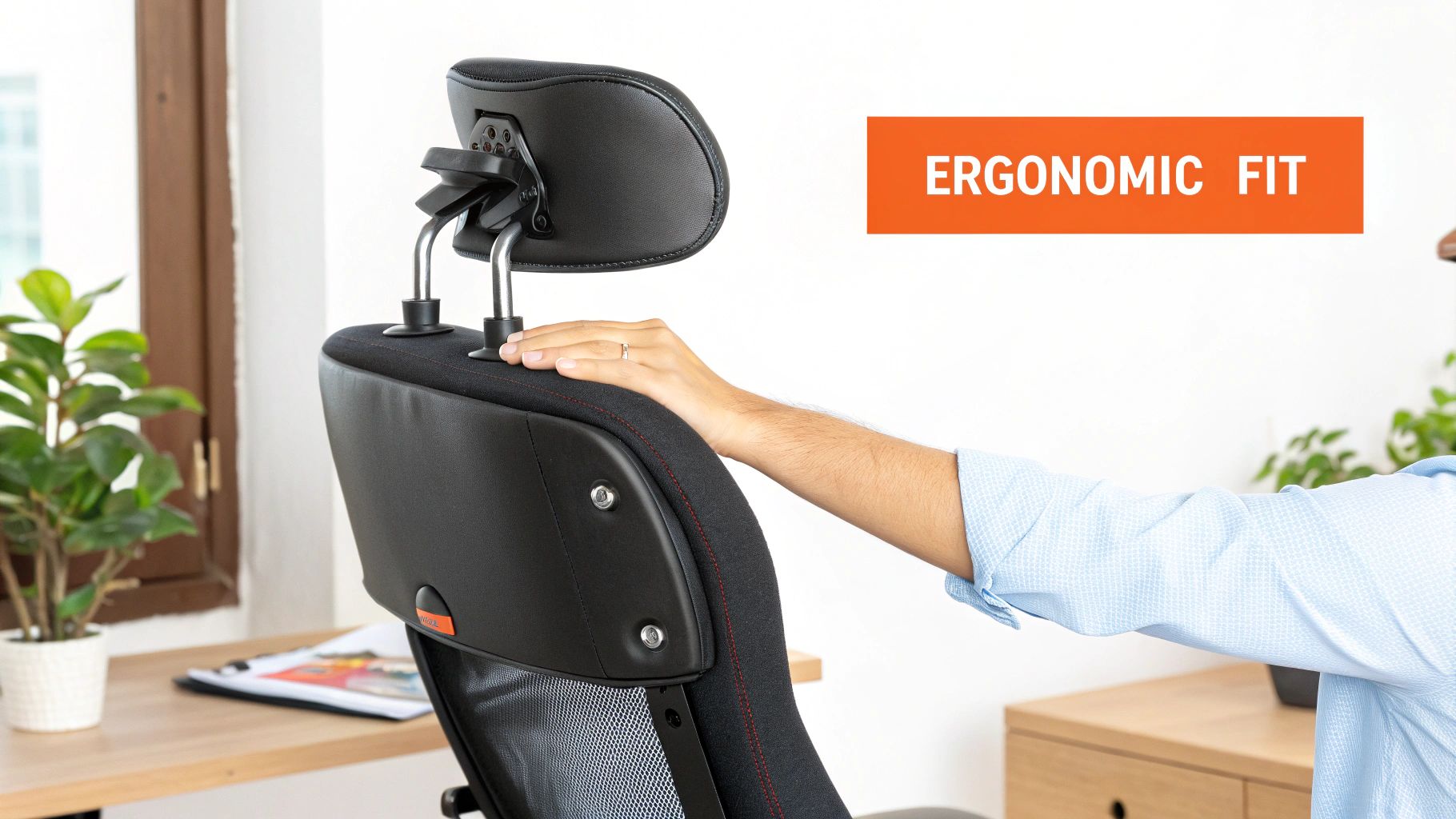
Sure, an office chair headrest adds a nice touch of comfort. But its real job is far more important: it’s a crucial piece of the puzzle for your spinal health. Getting your head and neck properly aligned sends a positive signal all the way down your back, actively preventing some of the most common aches and pains of office life.
Just think about what your body goes through during a long day at the desk. Without any support, your neck and shoulder muscles are in a constant state of low-level panic, working overtime just to hold up your head. This constant tension is a direct cause of strain, leading to those all-too-familiar tension headaches, sore shoulders, and a stiff upper back.
An ergonomic headrest gives your head and neck a place to go when you're not typing. It’s a chance for those overworked muscles to finally relax, which cuts down on fatigue and stops muscular stress from building up over the day.
Supporting You in Real-World Moments
You’ll really notice the difference a headrest makes when you lean back. It shines in those everyday moments you might not even think about.
- Deep in Thought: When you’re leaning back to think through a tricky problem, a headrest cradles your neck. This lets you focus on your work, not on feeling uncomfortable.
- Video Calls: On long conference calls, you can recline just a bit to look more relaxed on camera. The headrest keeps your posture in check without you even trying.
- Short Breaks: Taking a quick break to stretch or look away from your screen feels so much more refreshing when your chair supports your entire body, from the base of your spine to the top of your head.
These little moments of supported rest really add up. Just as your lower back needs proper support (you can learn more in our guide to understanding lumbar support), a headrest finishes the job by looking after your upper spine.
A well-designed headrest is one of the best ways to fight "tech neck" — that forward-leaning posture we all get from staring at screens. It encourages a natural, upright alignment and helps push back against the strain of modern work.
A Healthier Workspace, Step by Step
Ultimately, adding a headrest to your office chair is a smart, proactive move for your long-term health. It’s not just about soothing the aches you have now; it’s about creating a setup that stops them from happening in the first place.
By supporting the natural curve of your cervical spine (your neck), a headrest keeps your entire postural chain in good working order. This minimises the daily stress on your vertebrae and discs, leading to a healthier, more comfortable, and far more productive workday. It changes your chair from just a place to sit into a genuine tool for your wellbeing.
How to Choose the Right Office Chair Headrest
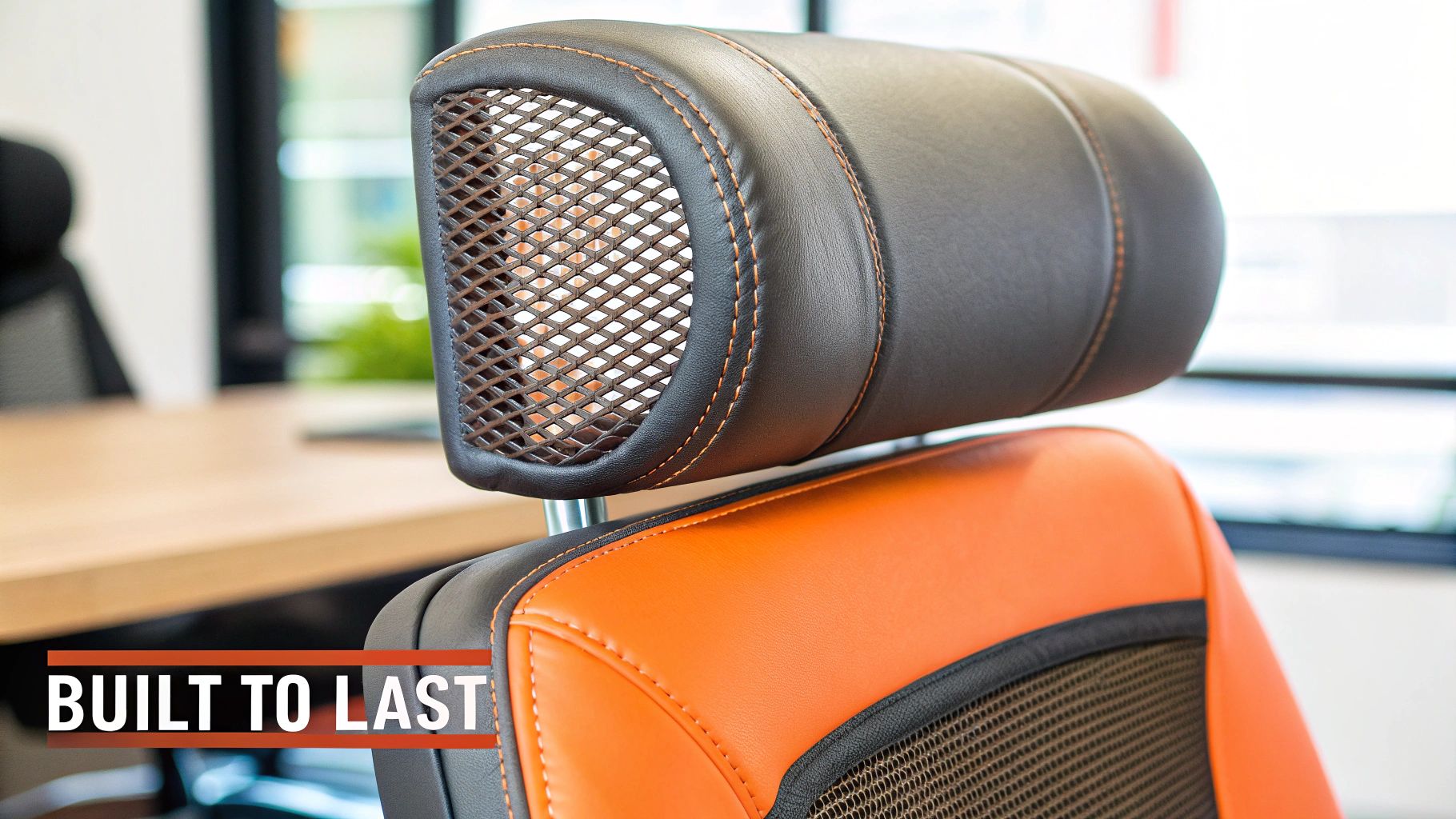
Choosing the right office chair headrest is a crucial part of setting up a truly ergonomic workspace. Whether you're buying a brand-new chair with a built-in headrest or adding one to your existing setup, there are a few things to keep in mind.
Get it right, and you'll end the day feeling supported. Get it wrong, and you might just end up with a stiff neck and a frustrating piece of plastic behind your head. It really comes down to a balance of adjustability, material, and making sure it actually fits your chair.
Adjustability Is Non-Negotiable
If a headrest can’t be adjusted, it’s not worth your time. Simple as that. A one-size-fits-all approach just doesn't work for something as individual as the curve of your spine.
A great headrest needs at least two types of adjustment to be truly useful:
- Height Adjustment: This lets you slide the headrest up or down. The goal is to position it perfectly in the nape of your neck, just below the base of your skull.
- Angle/Tilt Adjustment: This allows you to pivot the headrest. You want it to cradle your head gently, not push it forward into an awkward, chin-to-chest position.
Without these features, the headrest can easily become more of a hindrance than a help. It's a common complaint with fixed headrests that can actually throw your posture out of alignment.
Think about how you work. If you lean back often for phone calls or to think, a dynamic, highly adjustable headrest is a must. Even if you sit upright most of the time, you'll still appreciate a headrest that can be positioned correctly for those brief moments of rest.
Match the Material to Your Comfort
Ideally, the material of your headrest should match your chair for a seamless look, but your personal comfort should always come first.
- Mesh: This is a fantastic choice for keeping cool. It’s breathable, flexible, and conforms nicely to the shape of your neck and head.
- Fabric/Upholstery: Often much softer and more cushioned, fabric gives you a plusher feel. The trade-off is that it can be less breathable than mesh.
- Leather/Leatherette: Easy to clean and offering a premium look, leather can feel a bit less forgiving and may get warm after you've been sitting for a while.
Ultimately, the best material is whatever you find most comfortable. This is a personal preference, and it’s just as important as choosing the chair itself. For more advice on this, check out our in-depth guide on how to choose an office chair that ticks all your boxes.
Compatibility for Add-On Headrests
If you’re looking to upgrade a chair you already own, compatibility is everything. Not all chairs are built to have a headrest added on after the fact.
Before you buy anything, check if the manufacturer offers an official add-on for your specific chair model. This is the best way to guarantee a secure fit and, just as importantly, to ensure you don't void your chair's warranty.
Adjusting Your Headrest for Perfect Support
So, you've got a chair with a great headrest. That's a fantastic start, but the real magic happens when you dial it in just right. A poorly adjusted headrest isn't just useless; it can actually do more harm than good by pushing your head into an awkward forward position. The whole idea is to make it fit you perfectly, so it cradles your neck exactly where you need it.
It's also worth remembering what a headrest is actually for. It’s not meant to be used constantly while you're hunched over the keyboard. Think of it more as a support system for those moments when you lean back—to take a phone call, ponder a problem, or just have a quick stretch. It’s there to catch your head and neck, taking the strain off.
Fine-Tuning Your Headrest Height
First things first, let's get the height right. Most headrests slide up and down, and your goal is to find that sweet spot.
You’re aiming for the natural curve at the back of your neck, what’s known as the cervical spine. The headrest should nestle right into the nape of your neck, sitting just below the base of your skull. Too high, and it’ll uncomfortably push on the back of your head. Too low, and it’ll just be hitting your shoulders, offering zero support.
A simple trick to check the position is to sit up straight and then slowly lean back. Your head should naturally find the headrest, feeling gently supported without any weird pressure points.
Setting the Perfect Angle
With the height sorted, it's time to work on the angle. A lot of good headrests also pivot or tilt, which is a key feature for getting that neutral, supported posture. The goal here is to have the headrest meet your neck without forcing your chin down toward your chest.
You want to maintain a straight line from your ears down to your shoulders, even when you’re reclined. If you feel the headrest is shoving your head forward, it's throwing your spine out of alignment and creating tension. Keep adjusting the tilt until it feels like it’s simply filling the space between your neck and the chair back.
For a complete rundown on getting your entire chair set up for comfort, check out our detailed guide on how to adjust your office chair.
This simple infographic shows just how easy it is to install most add-on headrests—it's usually a matter of aligning, sliding, and locking it in.
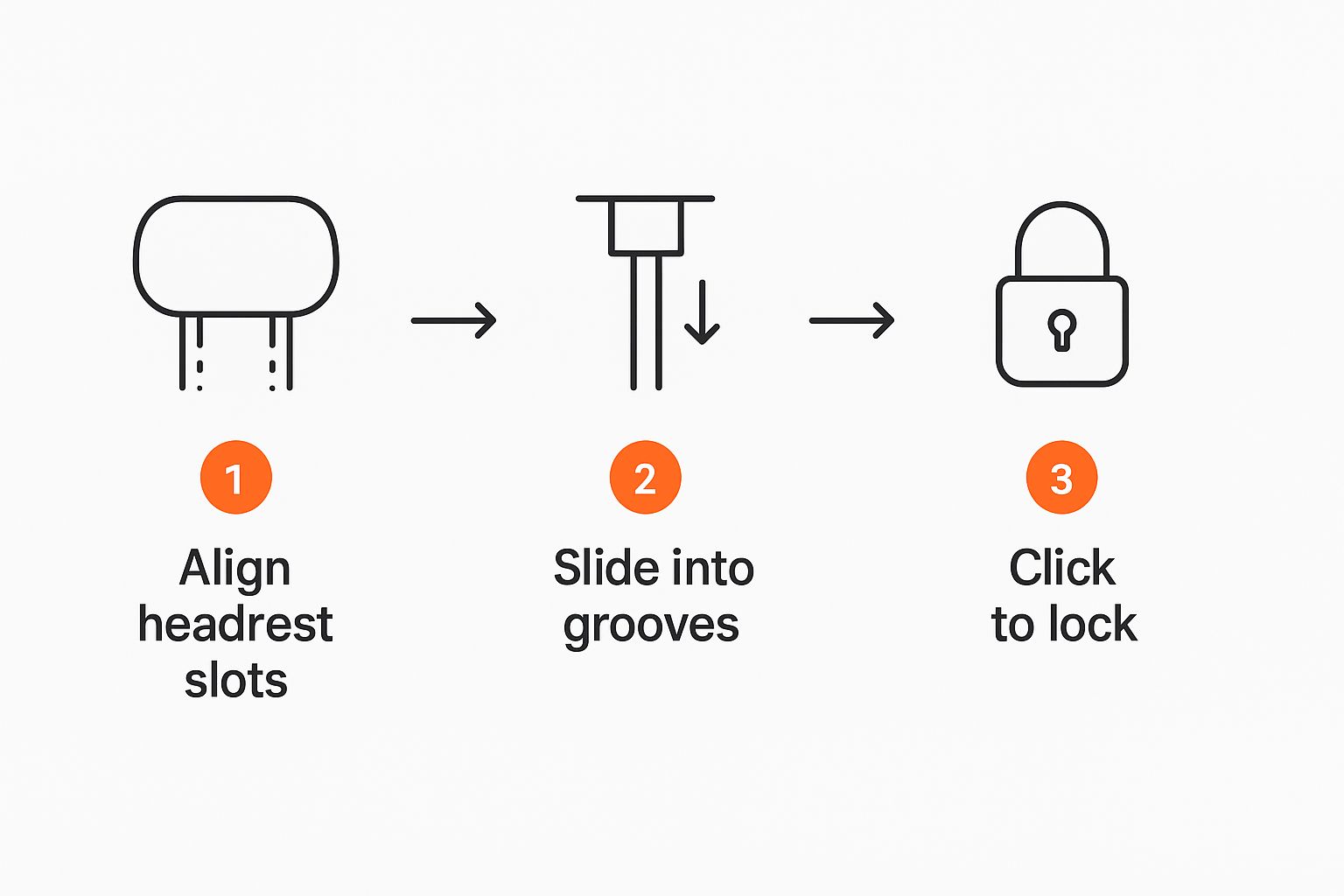
As you can see, adding a headrest is often a quick, tool-free job, making it a really accessible upgrade for pretty much anyone wanting better support.
How to Install an Add-On Headrest
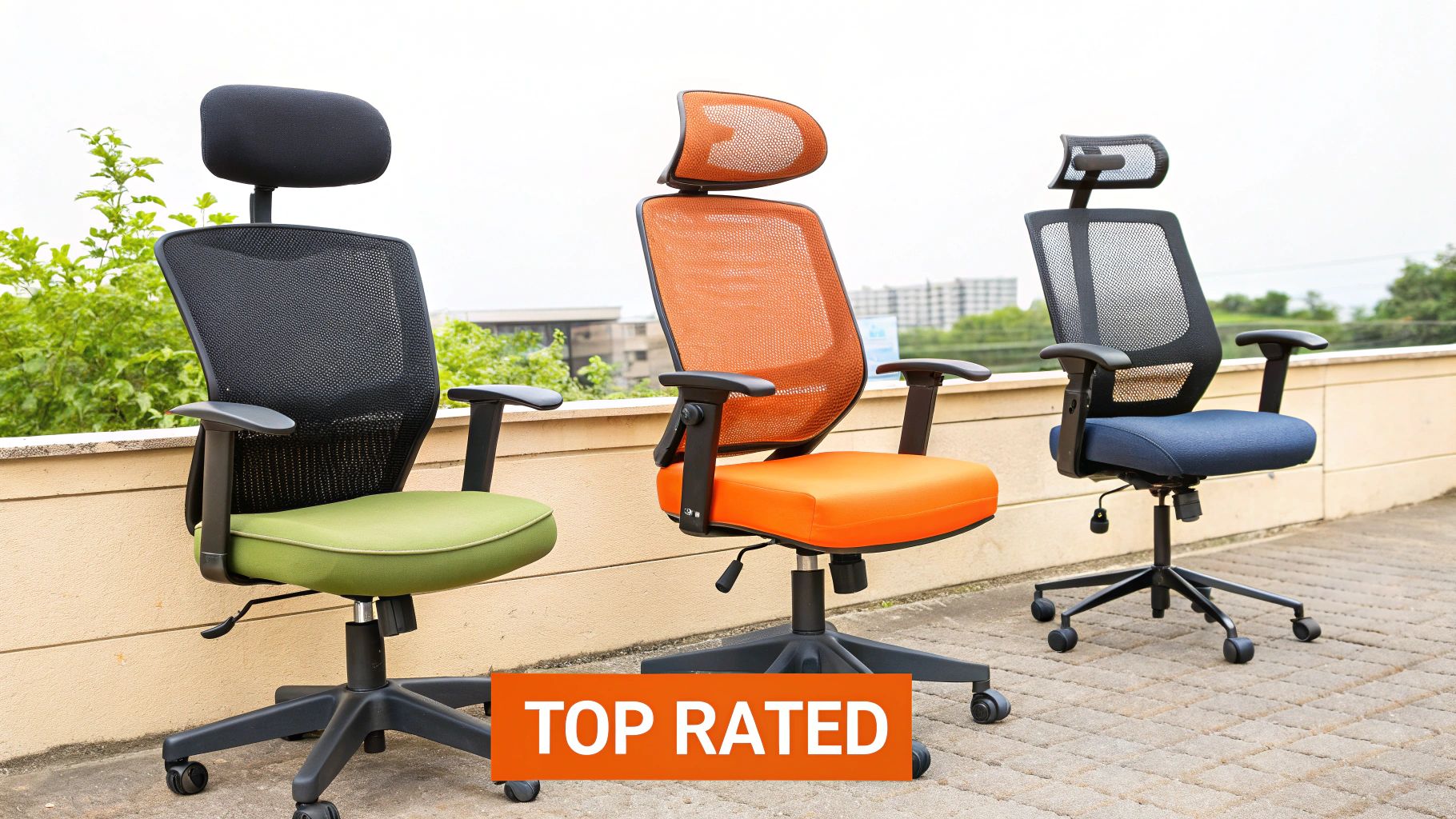
So, you're not quite ready to splash out on a brand new chair, but you desperately need some neck support? An aftermarket office chair headrest is a brilliant, cost-effective way to upgrade what you’ve already got. It can easily bridge the gap, giving you that extra comfort without a complete overhaul.
The trick, however, is making sure you get the right one and install it correctly.
Choosing a Compatible Headrest
First things first, you need to check if your chair can even take an add-on headrest. Many aftermarket options are custom-made for popular chair models, which guarantees a secure, seamless fit. While universal headrests exist, they often rely on clamps or straps that can look a bit clunky and may not feel as sturdy.
Your best bet is to find your chair's model number and see if the manufacturer sells an official headrest for it. If they don't, some great third-party companies specialise in making custom-fit headrests for well-known chairs. Try to find one that matches your chair’s colour and material for a look that says "factory-fitted."
Here's a crucial tip: check your chair’s warranty before you start drilling or modifying anything. Forcing an incompatible headrest onto your chair could easily void the warranty, leaving you high and dry if something else breaks down the track.
A Typical Installation Guide
The good news is that most aftermarket headrests are designed for a simple, straightforward installation. You'll rarely need more than a screwdriver or the Allen key that comes in the box. While the specifics will vary, the process usually looks something like this:
- Prepare Your Tools and Chair: Unpack the new headrest and lay out all the bits and pieces. You should have the headrest itself, a mounting bracket, and any screws you’ll need.
- Attach the Mounting Bracket: Line up the bracket with the top of your chair's backrest. It’s often designed to slide into specific grooves or screw into existing holes. Make sure it's dead centre and level.
- Secure the Headrest: Push the stems of the headrest down into the mounting bracket. You should feel or hear a solid click as it locks into place. Give it a gentle pull to make sure it's secure.
- Test and Adjust: Now for the best part. Sit down and adjust the height and angle of your new headrest until it perfectly cradles your head and neck.
A wobbly headrest is a common headache. If it feels loose, go back and double-check that every screw is fully tightened and the bracket is seated properly. A bit of re-centring is usually all it takes to fix any alignment issues.
Ultimately, nothing beats a chair designed from the ground up with integrated ergonomics, like a quality Pago chair from our website or a model from a retailer like Officeworks. But for a quick, effective, and budget-friendly upgrade, an add-on headrest is a fantastic choice.
Maintaining Your Chair and Headrest
Think of your ergonomic chair as a long-term investment in your well-being and focus. Like any quality tool, it needs a bit of care to keep it working perfectly for years to come. A little regular maintenance will ensure your office chair headrest and all its other moving parts stay sturdy, supportive, and looking sharp.
A simple cleaning and tightening routine can make a huge difference in how long your chair lasts. After all, it's the one piece of equipment you rely on for support, day in and day out.
Keeping Your Chair Clean
Different chair materials need different cleaning approaches to prevent damage. Here’s a quick rundown on how to handle the most common ones:
- Mesh: The best way to clean mesh is with a vacuum cleaner using a brush attachment to lift out dust. If you have a minor stain, a cloth dampened with a bit of mild soap and water usually does the job.
- Fabric: Vacuum your fabric chair regularly. If a spill happens, blot it straight away and use a proper upholstery cleaner—but always test it on a hidden spot first to be safe.
- Leatherette: This one's easy. Just wipe it down with a soft, damp cloth. Steer clear of harsh cleaning chemicals, as they can cause the material to dry out and crack over time.
This basic upkeep not only keeps your chair looking great but also stops grime from building up on important supportive areas like the headrest.
Tightening and Inspecting
With daily use, it’s completely normal for screws and bolts to loosen up a bit. Every so often, take a moment to check the fittings on your headrest, armrests, and the chair's base. A quick tighten with a screwdriver or an Allen key is all it takes to keep everything stable and stop any annoying squeaks.
This is especially true for the headrest. As more people in Australia’s knowledge-based economy spend long hours at their desks, there's a growing realisation of how much a good headrest can reduce fatigue in the neck and shoulders. As this awareness around ergonomics grows, so does the understanding that a well-maintained chair is crucial for getting the full benefit. You can find more detail on this in various ergonomic chair market reports. For more hands-on advice, our guide on common office chair repairs is a fantastic starting point.
Got Questions? We’ve Got Answers
Stepping into the world of ergonomic furniture often raises a few questions. That's perfectly normal. We've put together some answers to the most common queries about office chair headrests, so you can feel confident you're making the right choice for your workspace.
Do I Really Need a Headrest on My Office Chair?
Honestly, it depends on how you work. If you spend long hours at your desk or find yourself leaning back to think or take calls, then yes, a headrest is a game-changer. It provides crucial support for your head and neck, taking the strain off your cervical spine.
Think of it this way: without support, your neck muscles are constantly working to hold up your head. A headrest lets those muscles relax, which can make a huge difference in preventing tension headaches and shoulder aches. For short stints at a desk, you might not notice its absence, but for anyone in a full-time desk job, it becomes an essential ergonomic tool.
Can I Add a Headrest to Any Office Chair?
Unfortunately, it's not a one-size-fits-all situation. Most high-quality ergonomic chairs that offer a headrest option have one specifically designed for that model's frame. You can’t just attach any headrest to any chair and expect it to work. Always check your chair’s specific model first to see what compatible options are out there.
While you might find "universal" headrests online, they usually rely on less-than-ideal clamping systems. These can be wobbly and often lack the stability and adjustability of a purpose-built one. If you’re dealing with ongoing discomfort, our guide on the top office chairs for back pain might offer some helpful solutions.
How High Should My Office Chair Headrest Be?
The sweet spot is where the headrest supports the natural curve of your neck, right at the base of your skull (the occipital bone). When you lean back, your head should feel gently cradled, not awkwardly pushed forward.
The Goal: To keep your ears aligned directly over your shoulders, even when you’re reclined. If it's too high, it'll uncomfortably press on the back of your head. Too low, and it’s just supporting your shoulders, doing nothing for your neck.
Ready to experience what real comfort and support feel like? Explore the full range of ergonomic chairs at Pago International. For local availability, you can also find a curated selection of Pago chairs at Officeworks.


